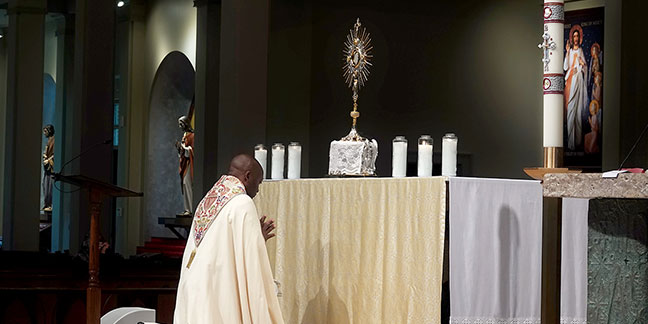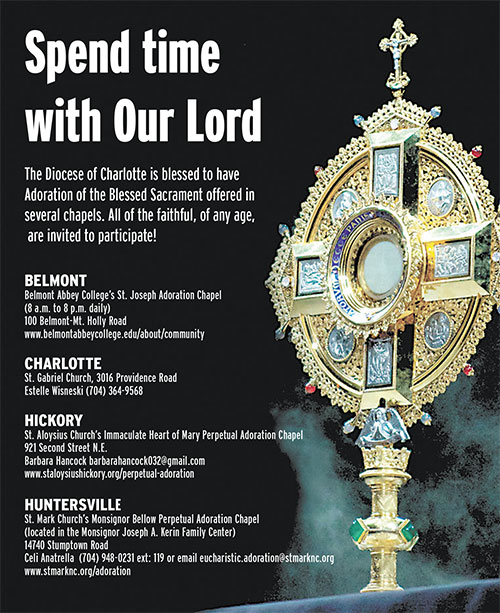
Prayer and meditation before Our Lord in the Blessed Sacrament are great ways to spend time with Him. Ask Him for graces for yourself or for loved ones, reflect on His Word, or just keep Him company.
All of our churches are open for people to come in and pray before the Blessed Sacrament in the tabernacle. Many also have specific times during the day or week for adoration of Our Lord exposed in the monstrance, known as Eucharistic Exposition and Benediction. This can include homilies by a priest, readings from Scripture, hymns such as “O Salutaris Hostia” and “Tantum Ergo,” and time for quiet adoration, after which the priest blesses the congregation in a Benediction of the Blessed Sacrament, followed by recitation of the Divine Praises.
Countless religious, including many saints and popes over the centuries, have extolled the great spiritual blessings and benefits we can derive from Eucharistic Adoration. St. John Paul II, calling it “a great treasure of the Catholic faith,” noted that “it nourishes social love” and encouraged all Christians to visit Jesus regularly in the Blessed Sacrament as “we are all called to abide in the presence of God.”
— Some info provided by ourcatholicprayers.com
More online
- A Beginner’s Guide to Eucharistic Adoration
- All Your Questions About Adoration Answered…What Is It? How Do I Go? What Do I Do? And More!
- FAQ regarding Adoration, the tabernacle and how to show proper reverence
Pictured above: Father Melchesideck Yumo, parochial vicar, genuflects during Eucharistic Exposition and Benediction at St. Mark Church in Huntersville. (Photo provided by Amy Burger)

Did you know?
Note with Covid-19 restrictions, times and locations may change. Please check with your local parish.
Two Eucharistic-themed hymns you’ll hear at Exposition and Benediction were composed by St. Thomas Aquinas in the 13th century: “O Salutaris Hostia” and “Tantum Ergo.”
The renowned saint and Doctor of the Church composed the text of “O Salutaris Hostia” for the feast of Corpus Christi, established by the Church in 1264 to honor Our Lord in the Eucharist (in His Body and Blood).
It actually comprises the last two stanzas of a larger hymn that he wrote about Our Lord’s institution of the Eucharist at the Last Supper and His Passion. It is often sung during Adoration of the Blessed Sacrament at Eucharistic Exposition and Benediction. The text is given below in Latin with an English translation:
O salutaris Hostia,
Quae caeli pandis ostium:
Bella premunt hostilia,
Da robur, fer auxilium.
Uni trinoque Domino
Sit sempiterna gloria,
Qui vitam sine termino
Nobis donet in patria. Amen.
O saving Victim, opening wide,
The gate of heaven to man below!
Our foes press on from every side;
Thine aid supply, thy strength bestow.
To Thy great name by endless praise,
Immortal Godhead, one in Three;
Oh, grant us endless length of days,
In our true native land with Thee. Amen.
In “Tantum Ergo,” St. Thomas Aquinas pays homage to Our Lord both in the Eucharist and in His glory in the Trinity. It comprises the last two stanzas of “Pange Lingua,” a hymn he also wrote for the feast of Corpus Christi. This hymn plays an important part in the Rite of Eucharistic Exposition and Benediction. “Tantum Ergo” is usually sung before the Benediction when the priest blesses the congregation with the monstrance. It is given below in Latin with an English translation:
Tantum ergo Sacramentum
Veneremur cernui:
Et antiquum documentum
Novo cedat ritui:
Praestet fides supplementum
Sensuum defectui.
Genitori, Genitoque
Laus et jubilatio,
Salus, honor, virtus quoque
Sit et benedictio:
Procedenti ab utroque
Compar sit laudatio. Amen.
Down in adoration falling,
Lo! the sacred Host we hail,
Lo! o’er ancient forms departing
Newer rites of grace prevail;
Faith for all defects supplying,
Where the feeble senses fail.
To the everlasting Father,
And the Son Who reigns on high
With the Holy Spirit proceeding
Forth from each eternally,
Be salvation, honor blessing,
Might and endless majesty. Amen.
Learn more
Read more about these hymns and listen to recordings of their musical settings


